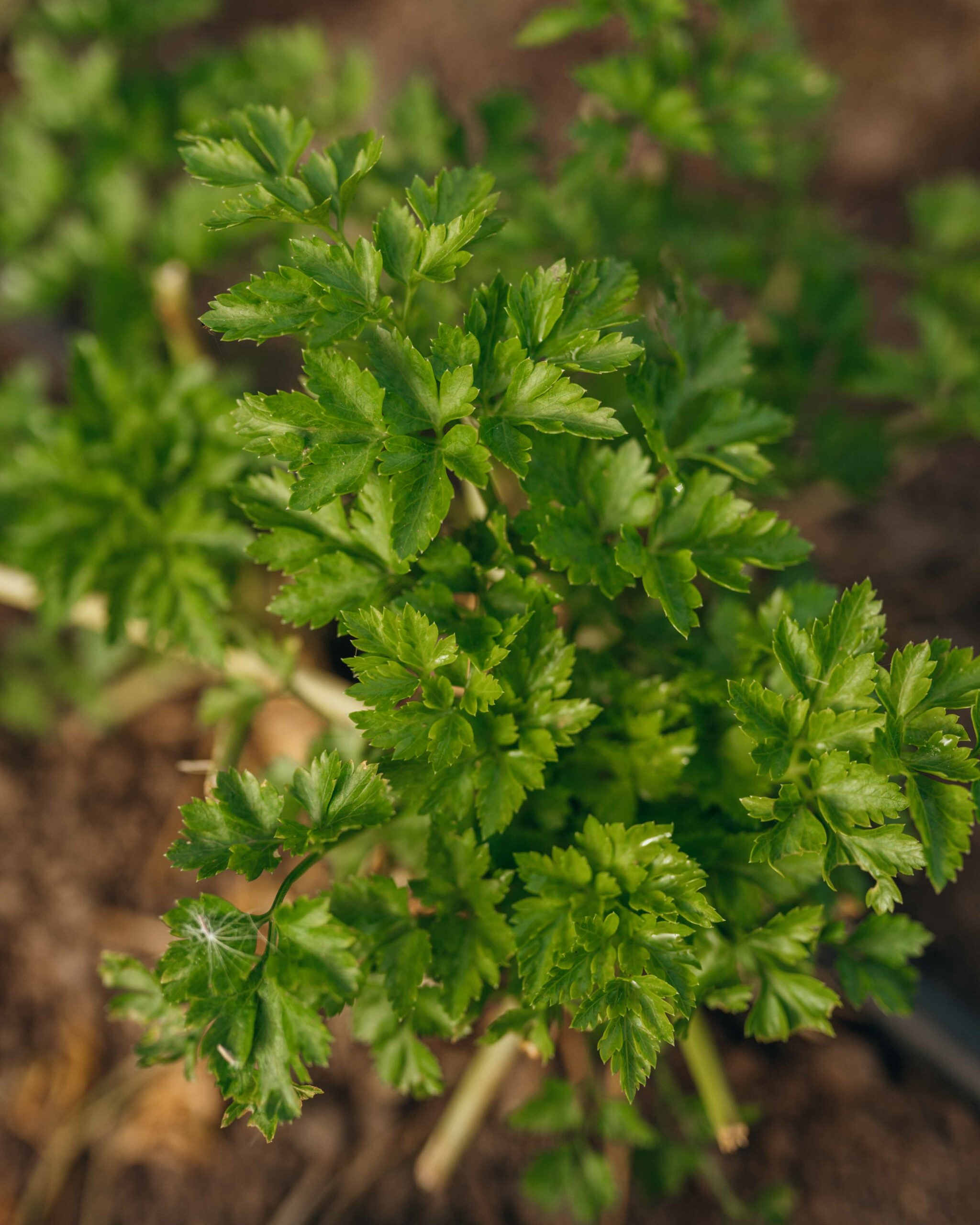Petroselinum crispum
PETERSILIE
Englische Bezeichnung: Parsley
Spanische Bezeichnung: Perejil
Familie
Apioideae
Hauptbestandteile:
-
Blatt: Flavonoide (Apigenin), Ascorbinsäure;
-
Pflanzenteile und Samen: ätherische Öle, die Apiol und Myristicin enthalten
-
Blatt und Wurzel: Cumarine
Verwendung:
Blatt, Samen, Wurzel
Wirkungsweisen:
-
Anti-arthritisch
-
Antibakteriell
-
Krebshemmend
-
Gerinnungshemmend
-
Antimykotisch
-
Entzündungshemmend
-
Gegen Steinbildung
-
Antimikrobiell
-
Antioxidativ
-
Antiparasitär
-
Fiebersenkend
-
Antitumor
-
Karminativ (beruhigend auf den Verdauungstrakt)
-
Harntreibend
-
Menstruationsfördernd
-
Gastroprotektiv
-
Hepatoprotektiv
-
Entspannend
-
Krampfhemmend
-
Uterus-Tonikum
Geschmack:
-
Wurzel: süß, scharf
-
Samen: bitter, scharf
-
Blatt: salzig, leicht bitter
Energie:
-
Wurzel: warm, feucht
-
Saatgut: neutral, trocken
-
Blatt: neutral
Ernte-Hinweise:
-
Blätter: zu einem beliebigen Zeitpunkt während der Wachstumsperiode ernten, zuerst die äußeren Stängel abschneiden
-
Samen: sammeln sobald sie auf natürliche Weise zu Boden zu fallen beginnen
-
Wurzeln: entweder im Herbst des ersten Jahres oder im Frühjahr des zweiten Wachstumsjahres ausgraben. Dazu die Blätter entfernen und entweder die Wurzeln schneiden und trocknen oder lagern in leicht feuchtem Sand
Viele Leute mögen Petersilie immer noch als das bisschen Grünzeug betrachten, das auf einem Restaurantteller schmachtet – dekorativ, aber normalerweise unberührt – obwohl sie zunehmend als eine der nahrhaftesten Komponenten einer Mahlzeit anerkannt wird.
Der lateinische Gattungsname der Petersilie, Petroselinum, bedeutet in etwa „Steinsellerie“: Das Wort stammt direkt vom altgriechischen πετροσέλινον ab, das in historischen Aufzeichnungen manchmal als Synonym für unsere Petersilie erscheint. Petro- ist von πέτρος, was „Stein“ bedeutet und -selinum von σέλινον, was „Sellerie“ bedeutet.
Eine der primären historischen pflanzlichen Indikationen der Petersilie ist für die Blasen- und Nierengesundheit, besonders wenn es um Steine geht, und das Kraut bleibt vielleicht am besten für diesen Zweck heute bekannt.
Petersilie wird auch als Verdauungshilfe verwendet, um Ungleichgewichte in der Menstruation zu adressieren, äußerlich für Wunden und Infektionen verwendet werden und vieles mehr (siehe Wirkungsweisen).
Resources:
Farzaei, M.H., Abbasabadi, Z., Ardekani, M.R.S., Rahimi, R., & Farzaei, F. (2013). Parsley: A review of ethnopharmacology, phytochemistry and biological activities. Journal of Traditional Chinese Medicine, 33(6), 815-26. https://doi.org/10.1016/s0254-6272(14)60018-2
Pliny. (1906). C. Plini Secundi naturalis historiae (K.F.T. Mayhoff, Ed.). Leipzig, Germany: Teubner. (Original work published 77 CE)
Family
Apioideae
Parts Used:
Leaf, Seed, Root
Key Constituents:
Leaf: flavonoids (apigenin), ascorbic acid
Aerial parts and seed: volatile oils containing apiol and myristicin
Leaf and root: coumarins
Harvesting Guidelines:
-
Harvest the leaves at any point during the growing season, taking from the outer stalks first.
-
Gather the seeds just as they begin to naturally fall to the ground.
-
One may dig the roots either in the autumn of its first year or in the spring of its second year of growth. Remove the leaves and then either cut and dry the roots or store them in slightly damp sand. If using the root for culinary purposes, however, do not remove the leaves until ready to cook.
Actions:
-
Anti-arthritic
-
Antibacterial
-
Anticarcinogenic
-
Anticoagulant
-
Antifungal
-
Anti-inflammatory
-
Antilithic
-
Antimicrobial
-
Antioxidant
-
Antiparasitic
-
Antiplatlet
-
Antipyretic
-
Antitumor
-
Carminative
-
Diuretic
-
Emmenagogue
-
Gastroprotective
-
Hepatoprotective
-
Relaxant
-
Spasmolytic
-
Uterine tonic
Taste:
Root: sweet, pungent
Seed: bitter, pungent
Leaf: salty, slightly bitter
Energy:
Root: warm, moist
Seed: neutral, dry
Leaf: neutral
Many people may still think of parsley as the bit of greenery that languishes on a restaurant plate-decorative but usually untouched-though it is increasingly recognized as one of the most nutritious components of a meal.
Parsley’s Latin generic name, Petroselinum, means roughly „stone celery“: the word derives directly from the ancient Greek πετροσέλινον, which sometimes appears in historical records as a synonym for our parsley. Petro- is from πέτρος, meaning „stone,“ and -selinum from σέλινον, meaning „celery.“
One of the primary historical herbal indications of parsley is for bladder and kidney health, especially when it comes to stones, and the herb remains perhaps best known for this purpose today.
Parsley is also used as a digestive aid, to address imbalances in menstruation, used topically for wounds and infections, and much more (see actions)!
Familia
Apioideae
Partes aprovechables:
Hojas, semillas, raizes
Principales Constituyentes:
Hoja: flavonoides (apigenina), ácido ascórbico
Partes aéreas y semilla: aceites volátiles que contienen apiol y miristicina
Hoja y raíz: cumarinas
Indicaciones de Cosecha:
-
Coseche las hojas en cualquier momento de la temporada de crecimiento, tomando primero los tallos exteriores.
-
Recoja las semillas justo cuando empiecen a caer al suelo de forma natural.
-
Se pueden desenterrar las raíces en el otoño de su primer año o en la primavera de su segundo año de crecimiento. Quitar las hojas y luego cortar y secar las raíces o guardarlas en arena ligeramente húmeda. Sin embargo, si se utiliza la raíz con fines culinarios, no hay que quitar las hojas hasta que se vaya a cocinar.
Propiedades:
-
Antiartrítico
-
Antibacteriano
-
Anticancerígeno
-
Anticoagulante
-
Antifúngico
-
Antiinflamatorio
-
Antilítico
-
Antimicrobiano
-
Antioxidante
-
Antiparasitario
-
Antiplaca
-
Antipirético
-
Antitumoral
-
Carminativo
-
Diurético
-
Emenagogo
-
Gastroprotector
-
Hepatoprotector
-
Relajante
-
Espasmolítico
-
Tónico uterino
Sabor:
Raíz: dulce, fuerte
Semilla: amarga, fuerte
Hoja: salado, ligeramente amargo
Energía:
Raíz: cálida, húmeda
Semilla: neutra, seca
Hoja: neutra
Many people may still think of parsley as the bit of greenery that languishes on a restaurant plate-decorative but usually untouched-though it is increasingly recognized as one of the most nutritious components of a meal.
Parsley’s Latin generic name, Petroselinum, means roughly „stone celery“: the word derives directly from the ancient Greek πετροσέλινον, which sometimes appears in historical records as a synonym for our parsley. Petro- is from πέτρος, meaning „stone,“ and -selinum from σέλινον, meaning „celery.“
One of the primary historical herbal indications of parsley is for bladder and kidney health, especially when it comes to stones, and the herb remains perhaps best known for this purpose today.
Parsley is also used as a digestive aid, to address imbalances in menstruation, used topically for wounds and infections, and much more (see actions)!








































